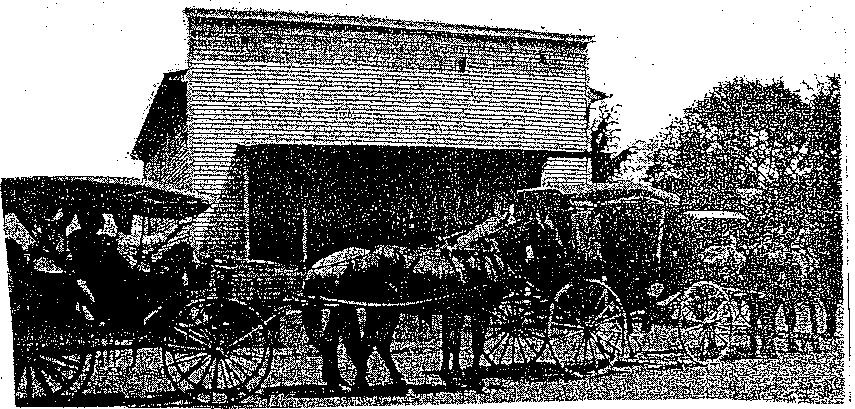
LIBERTY
Information collected by Marcia McKnight, from Clifford (Shorty) Ransom, Mickey Thomas'
Tales from the Aisles published in the Sentinel Tribune of Osceola and others.
From CLARKE COUNTY HISTORICAL & BIOGRAPHICAL RECORD
1886 Lewis Publishing
HISTORY

The picture postcard was submitted by Lois Bowlsby depicting a scene in the early 1900s, of a
Jamison crowd at Liberty, Iowa, on their way to Bethel Chapel.
The town of Liberty was located on the southwest quarter of the southwest quarter of section 5 and on the southwest quarter of the southeast quarter of section 6, in Liberty Township. It was surveyed and platted by Jerry Jenks, surveyor of Clarke County, about the year 1854. The first store in the town was kept by B.D. Truman, in the year 1856. In 1857, J.W. Hampton bought a stock of goods and continued to sell until May 22, 1862, when his store house and all the goods were burned at night, supposed to be the work of an incendiary. In the time of the Civil War, Thomas Hudgel sold goods for some time. For the last 12 or 14 years, Conrad Mowrey has been the merchant for Liberty. The first post office in the neighborhood was called Hickory Point, John Lambert postmaster. In the fall of 1856, the post office was moved to Liberty, and Jacob Proudfoot appointed. Libery was never incorporated as a town although it has a postoffice as early as 1856.
Jacob Proudfoot commenced to work at the blacksmiths' trade in Liberty in the spring of 1856, and in this year (1886) still has a shop in this place. He commenced is work at the blacksmith's trade in the spring of 1856, and this year (1886) still has a shop in this place.
Years ago the prospect was that Liberty would grow into quite a village, but the railroads caused towns to build up in other parts of the county, so that Liberty, without a railroad, has not improved much for a number of years.
WHO LIVED IN LIBERTY IN 1856?
The census taker said there were 212 males, 187 females, totally 399 inhabitants. 95 were farmers, 2 blacksmiths, 2 carpenters, 1 mechanic, 2 shoemakers, 1 engineer and 1 merchant. The largest number (150) were born in Ohio; 20 from Virginia, Iowa 47. Tennessee 9, Rhoce Island 3, Michigan 2, and 1 each from England, Maine, Vermont, New Jersey, Maryland and South Carolina. Early Liberty-ites were indeed a diverse people.
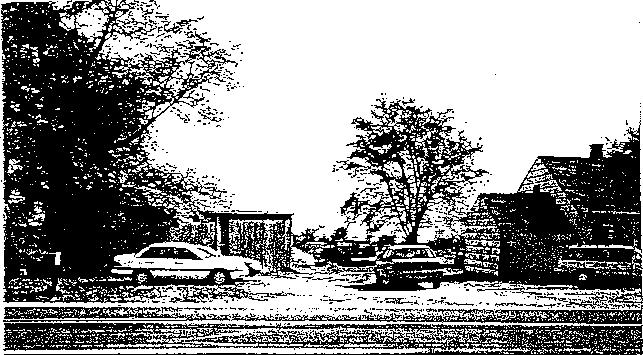
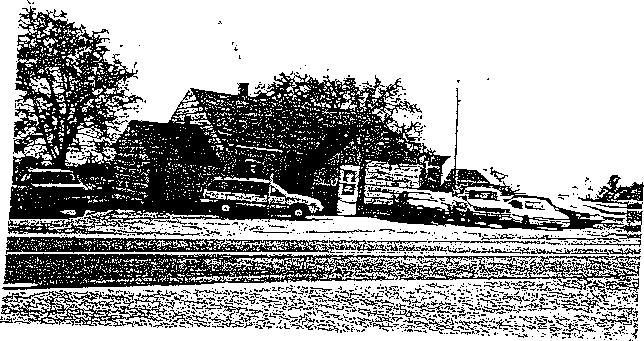
"Convenience store," gas station added 1969, became a residence, but zoning made it unavailable for that purpose. It was moved south of Osceola.
One of the earliest settlers was Alford Rhodes, born in 1808. He married Mary Jane Lambert, and they bought 40 acres of land for $1 in 1853. It became the town square. He started the Rhodes cemetery just north of Liberty, laid out in 1897.
A story has been preserved about a court case he was involved in: The first court was held at Osceola in 1854, by Judge Townsend. Every neighborhood seemed anxious to bring something before the new tribunal, and one of the first cases was between Alfred Rhodes and his son-in-law, John Campbell, both of Liberty Township. They had traded horses, and each accused the other of lying. Then each sued the other for slander. This was in a justice's court — 'Squire Miller's. Then it was necessary to transfer the scene of war to the Circuit Court, before which the whole neighborhood was summoned as witnesses. William Campbell, an uncle of John Campbell concerned in the suit, testified, and then the other side decided to impeach "old lyin' Bill Campbell." Al Stacy was first called up, and swore that Bill Campbell had a bad reputation for veracity. Another neighbor testified in the same strain, and then another. To the fourth witness, John Lambert, was then put the usual question: "How is Mr. Campbell regarded in your neighborhood as to truthfulness, etc.?" "Oh," drawled he, "I guess he's about an average of the neighborhood."
This, in connection with the preceding testimony as to Campbell's lack of reliability, was considered an excellent joke on "the neighborhood," and was well remembered through the county for a long time. The jury in the case gave Campbell 1c and Rhodes 62 1/2c, each to pay costs.
Francelia Reynolds' great, great grandfather, Levi Kerr, settled in Liberty Township in 1853. He came from Illinois and bought the land for $3 an acre. His son fought in the Civil War. Her grandparents, Don and Alice Kerr built a new home on that land, and Francelia's parents Raymond and Lela Nine, lived on the farm, which at that time had been in the family 150 years. (1 1/2 Century Farm).
The daughter of her great grandfather married a prominent Osceola attorney, E.K. Jones. Her grandmother married Frank Trumbo, who was a carpenter. Their son, Tom Trumbo, was killed on the last day of WWII. His body was brought back to the States the following year. His service was held in the Liberty Church, and he is buried in the Liberty cemetery, south of the Liberty community. Don and Alice Kerr were members of the Methodist Church at Liberty. Francelia remembers, "My grandmother was an active member of the Methodist Church. She died at a young age, 58. Both Don and Alice are also buried in the Liberty cemetery.
SCHOOLS
There were 9 rural schools in Liberty Township, two miles apart. #1 was "Snake Hole." #2 Snider or Snyder; #3 Liberty School, #4 Quiet Dell, #5 Center School (where Liberty Township people voted) #6 (Marquis) Hill, #7 Powell, #8 Victor; #9 St. George. Pictured in that order:
#1 not a photo, but a drawing.
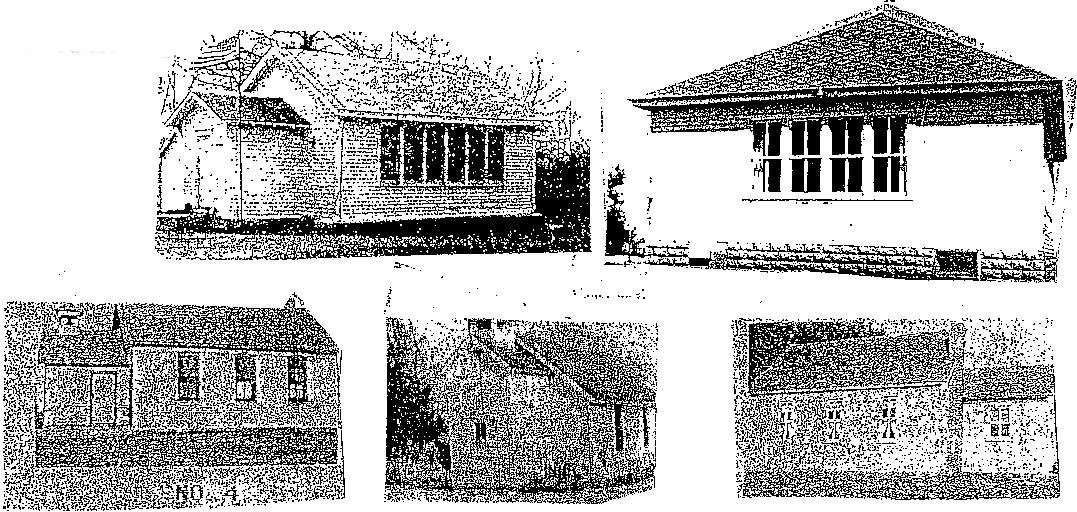

Richard McKnight wrote of his recollections of #3 school: Just off highway 69 in Liberty Township is a brown house with artificial log siding that was once Liberty School #3. It was a 1-room country school like we have all heard about. What is different about this country school is that it was my school from September 1951 until May 1958. In September of that year, I started riding a bus to "town" school. Liberty #3 closed the next year. Nothing was the same again.
It's hard to believe so many memories remain from only 7 years. It sounds old, but the more I remember, the more I remember. It was a 1-room school but it really had 3 rooms: One large room with rows of wooden desks all facing forward. The back of one seat was the front of the seat behind it. There were 9 rows of seats, one for each grade K-8. There was a green cloth curtain between the 5th and 6th rows that divided the lower classes from the upper classes. One teacher for K-4 and one for 5-8.
One of the two small rooms was used as a class recitation room for the lower classes. It was also where the teacher read stories to us (K-4) from the end of lunch to recess for a half-hour or so. The story I remember most clearly was Tom Sawyer.
The upper classes had their recitations at a table in the front of the desks on their side of the curtain. From 5th through 8th grade, we heard the upper class recitations. It made the transition from one grade to the next much easier. There was a big roll-up curtain across the front of the big room. When lowered it made a "stage" for plays the kids put on once each year. The parents came and sat in the desks and the kids were all behind the curtain.
The other small room on the main floor was a coatroom, a place for lunch sacks, and a big blue and white crock with a lid and a spigot. We poured water into it that we carried from my Grandma's well just across the road. It was an honor to be selected to go for water. We got to be out of school for awhile, and if we worked at it, the trip could take 20 minutes and we could grab an apple or a pear from one of Grandma's trees.
The restrooms were on the west side of the 1-acre site. One on the NW corner for girls and one on the SW corner for boys.
There were 2 basketball hoops with wooden backboards and 2 utility poles each.
The "court" was between the school house and the outhouses. There was a baseball field on the north side of the school house. I don't remember ever playing basketball, but we played softball all the time. Sometimes we would even play a game against another rural school. The best player I remember was Gary Glasscock. He was older than I was, and he could hit a home run.
I remember one time when I was so impressed because Gary Kimes let me wear his Hop-along Cassidy gun and holster set for one afternoon. I also remember one time when Gary Kimes had to climb in the window and walk back out again for 10 minutes or so because he jumped out the window to get to the swings early at recess. There were swings, a slide, and a merry-go-round for the younger kids. None of those pieces of equipment would be acceptable today, but we lived through it. Every spring there was a picnic to end the school year.
***************************
In his column "Tales from the Aisles" in the Osceola Sentinel Tribune, Mickey Thomas referred to a book "Rural Schools, Liberty Township." He quoted Wayne E. Swegle. "Every time I drive past Liberty #3 school, I feel a sense of Nostalgia for what I learned there. We got to know all the kids in school — the Davisons, McKnights, Trumbos, Sargents and others. We had small classes and dedicated teachers. We learned from each other. There were lower grades (1-4) and upper grades (5-8)." What he has written is fairly typical of all rural schools, which met their demise because of consolidation. In the 11th Volume of "Recipes for Living," the report that Clarke County completed closing Rural Schools in the late 1950s and early 1960s. In the early 2000s, there are those who, like Wayne, see the value of having had rural school education. He wrote, "We can't go back to country schools, but there may have been education approaches there worth considering."
CHURCHES
Also taken from the Clarke County record of 1886
There was a Bethel Chapel in 1841. The United Brethren organized a society about 1855. The Methodist Episcopal church was formed in the summer of 1856. The church was raised about the year 1860, but was not finished until 1865. The Methodists and United Brethren have societies and church services at the date of this writing (1886), the Methodist church numbering about 40 members, the United Brethren Society not so numerous, but they have another society a few miles out. The United Brethren closed in the late 1930s, and their church building was used for basketball, community programs, and reunions.
METHODIST CHURCH
1865-1969
Among the memorabilia of Patty Cowden's mother, Nancy Hoffman, was a framed copy of the Articles of Incorporation of the Methodist Episcopal Church of Liberty, Iowa, written in beautiful calligraphy. It is in the safekeeping of Richard and Marcia McKnight. It states: We, Andrew Jackson, Isaac Middleswart, Stephen F. Brown, Jacob Proudfoot, John Vanscoy, Joseph A. Meomis, and Isaac Walton of Clark and Warren Counties and State of Iowa have associated |
|
ourselves for the purpose of establishing and maintaining a Church Society in the Town of Liberty Clark County and State of Iowa and erecting a house of worship for the use of members and Ministers of the Methodist Episcopal Church to accomplish the ends of our association and by virtue of the Forty-third and Forty-fourth chapters of the Code of Iowa do adopt the following of association:
Article 1: The name of this Corporation shall be The Trustees of the Methodist Episcopal Church of Liberty, Iowa, and the said church assumes to itself as such Corporations all the powers specified in said chapter so far as the same are applicable to Corporations of this notice.and conduce legitimately to the attainment of its appropriate ends.
Article 2: This corporation takes the power of acquiring by grant, purchase or gift of holding and using in any manner not prohibited by law. All such property real and personal as may be necessary to its uses in order to carry out the object of the Corporation.
Article 3: The general nature of the transactions of this Corporation shall be the erection of a house of worship and to establish regulations for the government of said Church and to perform such other acts as may be necessary to effect its legitimate ends.
Article 4: The private property of any members of this Corporation shall not be liable for any of the acts thereof or any indebtedness resulting therefrom.
Article 5: Isaac Watson and Isaac C. Middleswat are appointed Commissioners to cause these articles to be recorded.
In witness whereof we have hereunto set our hands and seals this 17th day of January A.D. 1865. In the presence of John Daily, H.C. Sigler, Isaac C. Middleswart, Stephen F. Brown, Jacob Proudfoot,
Joseph A. Morris, Isaac Watson.
There is an undated article titled "Final Service Held Sunday at Liberty Methodist Church." The pastor, Rev. Anthony Pettrone, also pastored the United Methodist Churches at Medora and New Virginia. He was reappointed to Manson, Iowa. "There was considerable sorrow among parishioners from the Liberty community, and a few tears were shed when they were informed by Dr. Everett Staats, superintendent of the Des Moines District, that their church would be closed with the 9 a.m. service Sunday June 15. Church members received no previous warning. Dr. Staats will meet with the Liberty United Methodist Church trustees... at which time it will be decided whether the church will remain as a community building or be sold at auction and torn down."
The ladies of the church, the Liberty Ladies' Aid, continued to meet and minutes from their subsequent meetings have almost a funereal tone as they attempted to cope with the recent development. On June 4, 1969, the ladies met at the church, and announcement was made of a conference between the Church Trustees and the Township Trustees on the evening of June 23, 1969. The Aid would meet again on June 25 to hear the results of that previous meeting. Wanda Coffman suggested we still hold the Aid together, if possible. It was also suggested we give Rev. and Mrs. Petrone the Butterfly Quilt at a farewell dinner There was all kinds of talk about the Church closing. Other visiting went on also.
On June 25, 1969: A special meeting was called to see what the results of the trustee's meeting was about. Upon arrival at the church, we discovered the walls of the pulpit were bare. A reminder that it was no longer a church.
Wilma had devotions. She read a poem "Peace of Mind," and also read a prayer. Sec. Report was read and approved. We have $500.93 after our gift to Alice and Jim Sharp.
Mr. Kent White and Mr. Harley Pippin Liberty Township trustees, came to explain the church offer of disposal. Wanda C. suggested we put Aid things in the basement.
Question was asked: "When will the Church be sold?" Answer: Must make a bid within 1 week. Mr. Kent said: The township doesn't need the building. But as a township or community building there are no taxes. But there should be a responsible and trusted person in charge of the building. Nancy suggested the community incorporate for the protection of each person individually. And the insurance may be cheaper for a corporation than an Aid.
Mr. Pippin infoinied us the insurance drops on the building when it is sold.
Question: If incorporated, do we give it a name? Answer: Yes.
Mr. Kent: How much will the Aid bid on the church? If it goes to public auction, it must be torn down. Statts asked $500. Ben Wilson said Statts wouldn't take less than $500.
The building won't bring $100 at an auction. Because the school houses only brought $50 to $60. Ella made the motion: The Aid bid $200 for the purchase of the Church. Our top bid. Eithel seconded the motion. Voted: All yes, except for one not voting. Passed. Meeting adjourned at 3:15. The weather was stormy like our emotions.
In 2011, the Ladies Aid still meet the first Monday of each month from 1:00 to 3:30. They quilt and make quilts to give in case someone has a fire; they donate to Toys for Christmas, and take fruit baskets to shut-ins at Christmas.
BETHEL CHAPEL
The History of Three Bethel Churches — Christian Union in Christ
By Jackson B. Marquis, John W. Weakland in April 1949
The march of Christianity and human events caused this neighborhood and community to come forward with the necessary funds to build a much-needed church in which we worship. This church was built on the northwest corner of the cemetery which was purchased from John Short. The first person to be laid away in this cemetery was Freeman Welch. More land was purchased for this cemetery from Andy Welch.
The church was build by George Cunningham and was dedicated in 1869, by Rev. J.V.B. Flack of Pleasanton, Iowa. It answered all the purposes of a church until 1913, when it had to be repaired. The community thought it best to sell the old church and it was sold.
Alva Wilkins donated a piece of land just west of the old church on which new one was to be built. The community was called upon to supply the funds to build the second church. This church was dedicated in 1913, by Rev. Thomas of Milo, Iowa. It was used as a place of worship until 1930, when it was destroyed by fire. The community was called upon to supply funds to build the third church to be erected on almost the same site as the previous two churches. This church was dedicated in June 1932, by a minister from Missouri, assisted by Rev. Andy Darrell. A wonderful neighborhood and community.
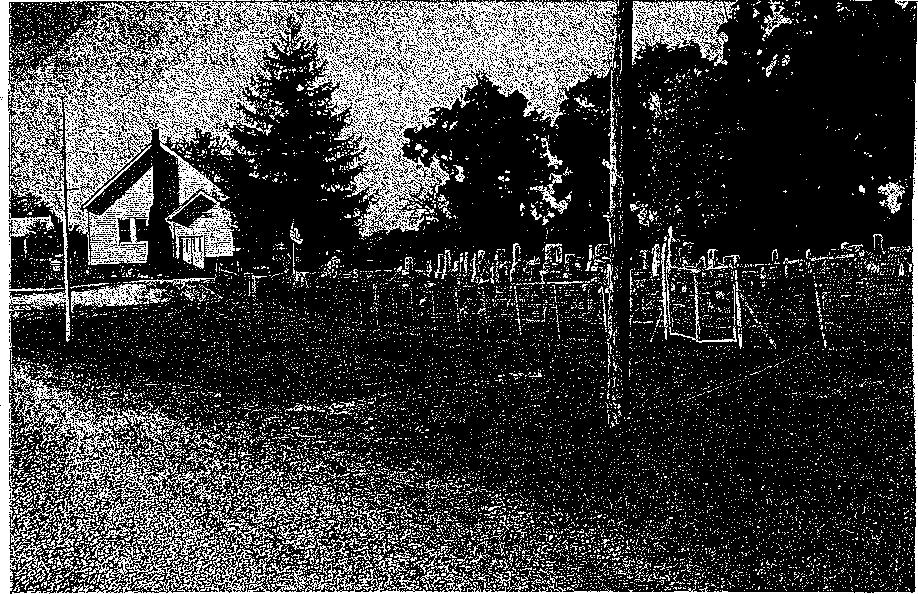
Bethel Chapel and Cemetery Founded 1869
PARKS
Picture appearing in the Osceola Sentinel Tribune of the Thursday August 30, 2001 issue. The caption reading — This vacant block in Liberty, platted as the town square nearly 150 years ago, may become the next Clarke County park. The county supervisors have given their support to making the property, whose ownership is uncertain, into a park.
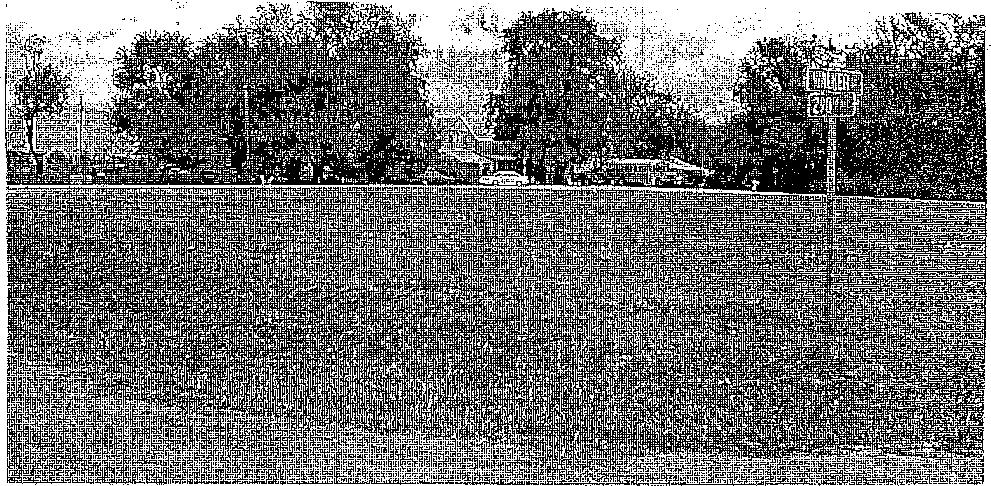
The Clarke County Supervisors Friday gave their initial support to a proposal to make the Liberty town square a county park. A group of Liberty-area residents requested the action by the supervisors. About 200 signed a petition urging the county to take over the vacant lot, which measures 280x280 feet.
Research by County Assessor Walt Paschell indicates the history of the square dates to 1854, when Alfred Rhodes surveyed the Town of Liberty. In 1923, Rhodes' widow and son deeded the square to Earl Chumbley. However, the property has not been on the tax rolls for many years and the ownership of it is uncertain.
"If none of the residents come forward, I think we can get a deed to it without too many problems," Supervisors' Chairman Terry Robins, said. County Engineer Rich McKnight said the next step was to get the Clarke County Conservation Board to agree to accept the property. That board will meet. Tuesday Sept. 4. He said Conservation Director Anita Foland had pledged to support the request. Robins said he would like to know how expensive it will be to maintain the lot before making a final commitment to convert it to a park. "I would like to have some idea how much more this is going to cost the Conservation Board," he said. "I envision a shelter house or something up there in the future."
One of the nine Liberty-area residents who attended the meeting said public restrooms would be a good idea for the new park. "There's 4 cemeteries up there and no restrooms," he said. "When people come from long distances, there's no stores or anything anymore."
Liberty, in Liberty Township, is not incorporated and does not appear on state maps. The hamlet has about 10 houses, located just off U.S. Highway 69 at the end of Liberty Highway. The park would lie between 290th and 291st avenues and be bounded by Walker Street to the south and Williams Street to the north. "I think it'd be an ideal place for a park," Robins said.
Supervisor Don Reasoner said it could be similar to the successful Hopeville Square County Park. "It's really nice down there," he observed. He said it would just take time to get the park built up like Hopeville's.
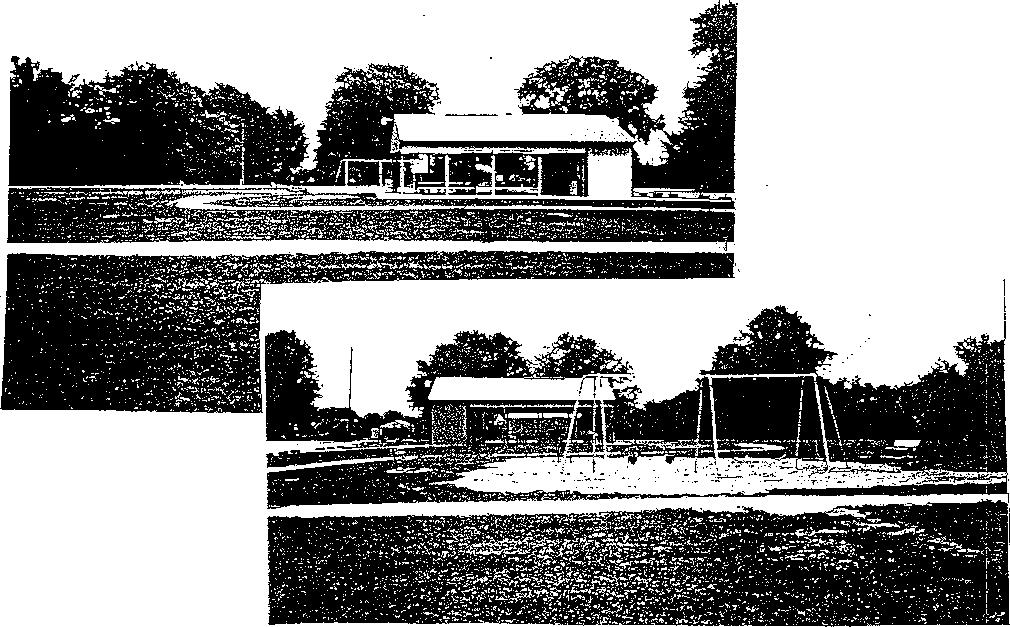
Clarke County Supervisors' meeting 6-5-03, as reported in the Osceola Sentinel Tribune: Moved by Manley, seconded by Cooley, to approve an agreement between the Conservation Board and the secondary Road Dept., on sharing costs for restrooms at Liberty Park. The Conservation Board will contract with Southern Iowa Rural Water Assn. to install rural water. The initial meter fee of $400 will be paid by the Liberty Park Restoration Committee, and all subsequent billings will be paid by the Conservation Board. The Secondary Road Dept. will have access to the restrooms and will compensate the Conservation Board an amount not less than $34 per month (minimum monthly water bill) and not exceed $20 per week (amount being paid for a portable toilet) not to exceed the total cost of the monthly water bill. Agreement will be subject to annual review. "Ayes" all.
Return to main page for Recipes for Living 2011 by Fern Underwood
Last Revised February 13, 2015